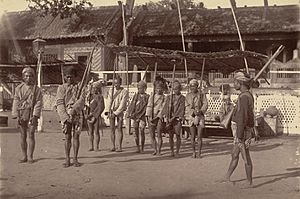Willoughby Wallace Hooper facts for kids
Quick facts for kids
Willoughby Wallace Hooper
|
|
|---|---|
| Born | 4 February 1837 Kennington |
| Died | 21 April 1912 Kilmington |
| Nationality | British |
| Occupation | Military photographer |
| Known for | ethnographic photographs of native people in colonial India and Burma |
| Works | The People of India (1868–1875), Burmah: a series of one hundred photographs 1887 |
Willoughby Wallace Hooper (born in Kennington, London, in 1837 – died in Kilmington, England, in 1912) was a British military officer. He was also a talented photographer. He spent almost 40 years serving in the army in India and British-Burma. This was during the second half of the 1800s.
Hooper is well-known for his pictures of different ethnic groups. He also photographed military scenes and daily life starting in the 1860s. He helped create a large collection of photos called The People of India. This collection showed many different people from India. His photos of the Madras famine of 1876-78 showed the very difficult times people faced.
Hooper's Life and Photography Work
After finishing school in Ramsgate, Hooper started working in 1853. He became a secretary at East India House. In 1858, he joined the 7th Madras Light Cavalry. He was later given special permission to take photos of different groups of people. He did this in the Central Provinces of British India and later in British Burma.
Hooper taught himself photography and loved it. He took over 450 pictures of Indian people for the book series The People of India. This series was published from 1868 to 1875. In a letter from 1862, he wrote about how hard it was to photograph a remote hill tribe. He said they had never seen a European before and were very scared. It was also difficult to explain what he was doing with his camera.
Around 1872, Hooper created a series of staged photos called "Tiger Shooting." He sold these pictures to hunters as proof of their hunts and as souvenirs. He later re-edited them in 1887 as Lantern readings: Tiger shooting in India.

In 1885, he took part in the Third Anglo-Burmese War. He served as a military police officer, called a Provost Marshal. This war ended the rule of the last Burmese king, King Thibaw. It also led to Britain taking control of the entire country. Hooper's photos of this war are seen as a very complete record of a 19th-century military event.
His war photos were published in 1887. The book was titled Burmah: a series of one hundred photographs illustrating incidents connected with the British Expeditionary Force to that country, from the embarkation at Madras, 1st Nov, 1885, to the capture of King Theebaw, with many views of Mandalay and surrounding country, native life and industries. There were two versions of the book. He also made a set of lantern slides from these photos.
In 1896, Hooper retired from the military as a colonel. He lived in England until he passed away in 1912. Many of his photographs are kept in the archives of the British Museum and the J. Paul Getty Museum.
See also
Other famous photographers from 19th-century Burma:
- John McCosh
- Felice Beato
- Linnaeus Tripe
- Philip Adolphe Klier
- Max Henry Ferrars


